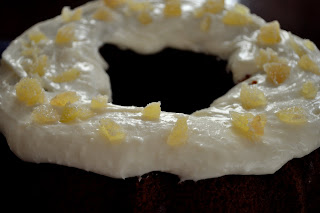
America, we're behind. Though cauliflower originated in
To reiterate, hiding this beautiful white vegetable under cheese is wrong. I don’t care what pseudo celebrity is doing just that. Even if she's doing it on Oprah. Who, by the way, should use her influence more responsibly, like supporting these guys. Cauliflower doesn’t need a cheese sauce. This is a vegetable which was a centerpiece on the feast tables of Louis the XIV. The original food bible Théâtre d'Agriculture (1600) praised the cauliflower as a “delicate vegetable.” It's a close cousin of kale, broccoli, and brussel sprouts, all of which are treated like adults. So eat them as such.
Mark Twain wrote that cauliflower is “cabbage with a college education.” I’d say it’s more like broccoli that has gone to finishing school. Cauliflower is elegant and soft spoken. It’s considerate: see how it’s wearing white so it won’t clash with anything on your plate? And most importantly, if it gets stuck in your teeth your friends are much less likely to see. Cauliflower wants you to save face and waist. Though of course if your friends did notice, they wouldn’t be so crude as to mention it. What kind of party do you think this is? One with cauliflower cheese?
Curried Cauliflower Soup
I fulfilled my patriotic duties and ate way too much at Thanksgiving (and the following days, thanks to an expanded stomach). The leftovers are finally, thankfully, almost gone because I can’t handle one more plate of a stuffing-sauce-sprouts-sweet potato collage. Give me simplicity. Give me health.
To restore my post-holiday balance, at least until Christmas cookie decorating, I decided to make this, the anti-Thanksgiving dish. It’s made in just one pot. It’s vegetarian—actually vegan if you don’t add the yogurt topping. It’s healthy and it’s Indian, but not the Native American kind. Curried cauliflower soup, heal my buttery soul.
This recipe is adapted from Moosewood, one of the first vegetarian restaurants in the
ingredients:
2 tbsp olive oil
1 1/2 cups chopped onion
2 cloves garlic, minced
1 tbsp fresh chilies or dried red chilies, minced (and OK fine, red pepper flakes if that's what you've got)
1 tbsp grated fresh ginger
1 tsp turmeric
1 tsp cumin
1 tsp coriander
1/2 tsp cinnamon
2 cups cubed red potatoes
1 head cauliflower, cut into florets (about 4 cups)
4 cups vegetable stock
salt
1/4 cup basmati rice
2 tbsp lemon juice
1 tsp sugar
4 tbsp fresh cilantro, chopped (more if you're like me and like a heavy cilantro garnish)
black pepper
greek yogurt (optional, but recommended, to dollop on top. Its cold creaminess plays against the warm curry flavor. yum!)
directions:
Heat olive oil in a large soup pot over medium heat. Add the onion, garlic, ginger, chilis and a tsp salt. Cook, stirring occasionally, until the onions are translucent, about 10 minutes.
Add the turmeric, cumin, coriander and cinnamon to the pot. Stir constantly for a minute or two to let the spices get fragrant.
Add the potatoes, cauliflower, stock, and another teaspoon of salt to the pot.
Cover the pot and bring the broth to a boil. Add the rice and cover the pot again. Let simmer for 15 minutes, when veggies should be tender.
The recipe says to puree 2 cups of the soup in a blender. I used my immersion blender (the turmeric stained the bottom... whoops) and just blended until it was the consistency I wanted. Frankly, you don't need to blend this soup at all if you think it's a bother. You'll just have a very chunky soup. I pureed enough to make the broth noticeably thicker and creamier, but left nice pieces of cauliflower and potatoes floating like icebergs in a curry sea.
Add the lemon juice, sugar, and cilantro. Add salt and pepper to taste. Remember that this is a BIG pot of soup, so it will require liberal seasoning. Serve, with an added dollop of yogurt in each bowl if desired.
















































